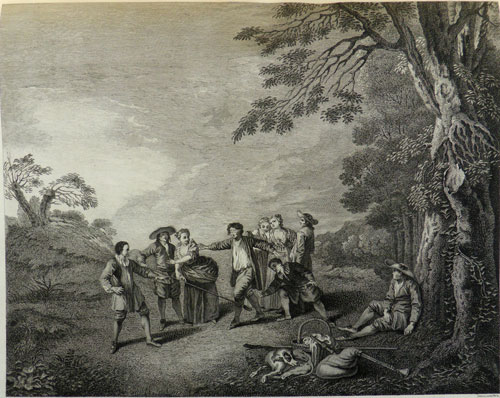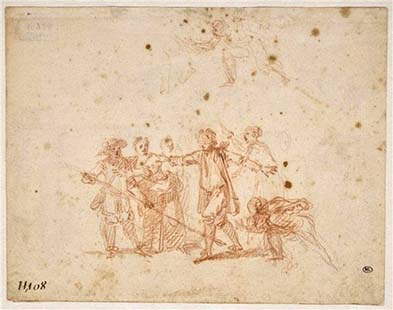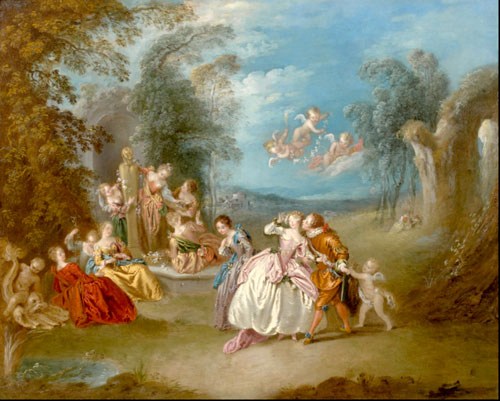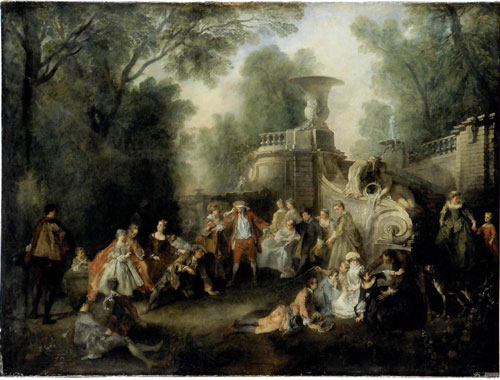
- Home Page
- Accepted
Paintings & Copies - Doubtful
Attributions - Doubtful Textual References
- Alternative
Titles - Collectors &
Museums - Bibliography
- Search Abecedario
- Watteau &
His Circle
Le Colin maillard
Entered January 2019; revised November 2021

Presumed lost
Materials unknown
51.3 x 64.8 cm
RELATED PRINTS
Etienne Brion after Watteau, Le Colin maillard, 1730, engraving.
Watteau’s painting Le Colin maillard was engraved in reverse by Etienne Brion for Jean de Jullienne’s Oeuvre gravé. The print was announced for sale in the June 1730 issue of the Mercure de France (p. 1184).
PROVENANCE
Paris, collection of Jean de Jullienne (1686-1766; director of a tapestry factory). Julienne’s ownership is indicated under the engraving: “Tiré du Cabinet de Mr Jullienne.” He sold the painting prior to 1756 since it does not appear in the illustrated catalogue of his collection that was prepared that year; the manuscript is now in the Morgan Library & Museum, New York.
London, sale, Cock’s, 1731, lot 37: “ Watteau . . . Blind Man’s Buff.”
SELECT BIBLIOGRAPHY
Hédouin, “Watteau” (1845), 79.
Hédouin, Mosaïque (1856), cat. 88.
Goncourt, L’Art au XVIIIème siècle (1860), 58.
Goncourt, Catalogue raisonné (1875), cat. 187.
Dacier, Vuaflart, and Hérold, Jean de Jullienne et les graveurs (1921-29), 2: 104-06; 3: cat. 212.
Réau, “Watteau” (1928), cat. 108.
Mathey, “A propos d’une catalogue” (1938), 160-61.
Adhémar, Watteau (1950), cat. 31.
Mathey, Watteau, peintures réapparues (1959), 66.
Eidelberg, Watteau’s Drawings (1965), 18-20.
Macchia and Montagni, L’opera completa di Watteau (1968), cat. 10.
Ferré, Watteau (1972), cat. B42.
Raines, “Watteau and ‘Watteaus’ in England” (1977), 56, 59.
Roland Michel, Watteau (1981), cat. 7.
Roland Michel, Watteau (1984), 176, 212, 266, 289.
Grasselli, Drawings of Watteau (1987), 54, 68-69.
Rosenberg and Prat, Watteau, Catalogue raisonné des dessins (1996), under cat. 10.
Valenciennes, Musée, Watteau et la fête galante (2004), cat. 78.
Glorieux, “L’Angleterre et Watteau” (2006), 57, 70.
RELATED DRAWINGS
Watteau’s Le Colin maillard is one of several early paintings that can be linked directly to full compositional studies; the others include Les Délassements de la guerre and Le Repos gracieux. Their combined evidence suggests that in his early career Watteau followed traditional modes of working. Later, he composed more directly on the canvas.
A study for Le Colin-maillard is recorded in a counterproof now in the Louvre (Rosenberg and Prat 10). The other side of the sheet shows a series of separate figures, apparently not drawn from life and unrelated to each other. The latter figures are decidedly Gillotesque in spirit but not in draftsmanship. Nonetheless, both sides of the sheet were credited to Gillot until 1938 when Jacques Mathey first recognized these as by the young Watteau. Prior to then it had been assumed that Watteau had borrowed his master’s sketch for his painting. But now, with the realization that the drawing is Watteau’s own invention, other questions arise: was this a game that Watteau actually observed and drew, or, more likely, was he working from his imagination, posing the figures in a lively arrangement? The study is rapidly drawn, and some of the figures, such as the kneeling man in the foreground, are not fully realized, but a secondary sketch at the top of the page offers greater resolution.
REMARKS
Although we have little information about the picture, Le Colin maillard, that sold in London in 1731, it seems likely that this was the original Watteau painting. It was engraved only the previous year, leaving very little time for the engraving to have circulated and been copied. The actual sale catalogue has not survived as well. All we have is Richard Houlditch’s transcription and that does not record the selling price nor the buyer’s name. It has not been possible to trace the painting in subsequent eighteenth-century sales in England.
Scholars agree that Le Colin maillard is a very early painting. The overall proportions of the figures—elongated and with small heads—is a clear indication of this. The stiffness of pose of the men at either side, one seated, the other standing, affords additional evidence of the artist’s lack of skill. But, as always, there is no agreement as to exactly when the painting was executed since there are few chronological markers in Watteau’s juvenilia. Mathey proposed c. 1705-05; Roland Michel suggested 1705-08; Adhémar favored 1705-09; Rosenberg and Prat dated the Louvre drawing to c. 1708; Eidelberg suggested c. 1708-10. One of the major obstacles in dating Watteau’s early works is that we do not know when he started to paint independently.
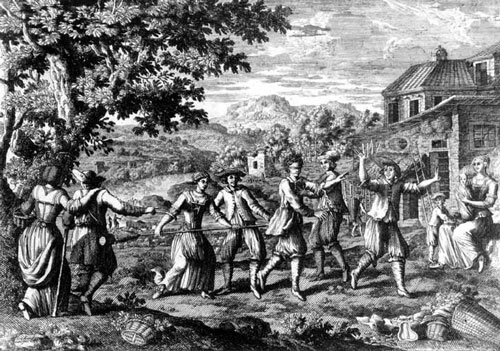
Adam Pérelle, Le Jeu de colin maillard, c. 1660-1695, engraving.
Although games figure frequently in French eighteenth-century paintings, they were still a novel subject in Watteau’s era. There are precedents, primarily in graphic arts, such as Adam Pérelles’ engraving of Le Jeu de colin maillard. But such precedents are rare and did not demonstrably influence Watteau’s choice of subject.
Surprisingly, Watteau did not return to the theme of blind man’s buff in his later career, certainly not with the same frequency that he depicted scenes of women on swings. In contrast, his pupils Pater and Lancret (but not Quillard) repeated the subject many times over. Although Watteau’s characters are fashionably dressed, the landscape and the bagpipes in the foreground create a pastoral ambience. With Pater and Lancret the scene shifts perceptibly to a richer, more courtly society, sometimes in a palatial setting. In many of Pater’s paintings, cupids assist in what now is a playful game of love.
Click here for copies of Le Colin maillard
